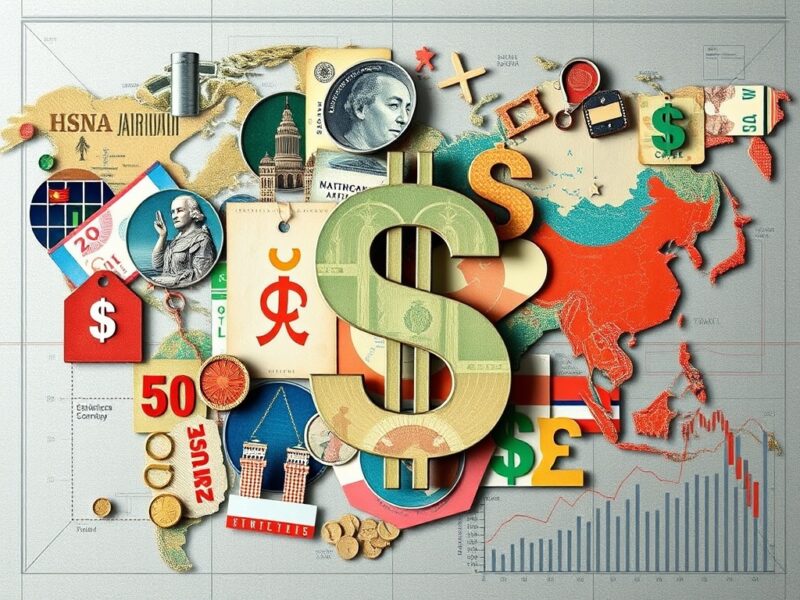Asia FX: Unlocking Crucial Insights Amid US-China Trade Dynamics and Dollar Stability
0
0

BitcoinWorld

Asia FX: Unlocking Crucial Insights Amid US-China Trade Dynamics and Dollar Stability
In the fast-paced world of global finance, every ripple in the traditional markets can send waves across the cryptocurrency landscape. While your focus might often be on Bitcoin’s latest moves or Ethereum’s next upgrade, understanding the foundational shifts in the Forex Market, particularly in key regions like Asia, is crucial. Today, we delve into the subtle yet significant movements of Asia FX, the persistent shadow of US-China Trade relations, and the intriguing question of Dollar Stability ahead of critical CPI Data. How do these seemingly distant events influence the liquidity, investor sentiment, and overall health of the digital asset space? Let’s explore.
Understanding Asia FX Movements: A Calm Before the Storm?
The currencies of Asia have recently displayed a remarkable calm, moving with minimal volatility. This period of relative tranquility in Asia FX might seem uneventful, but for seasoned investors and market watchers, it often signals a moment of anticipation. Central banks across the region, from the Bank of Japan to the People’s Bank of China, maintain a vigilant watch, often intervening subtly to ensure economic stability and manage currency valuations. This delicate balancing act aims to protect export competitiveness while curbing inflationary pressures.
Key factors contributing to the current Asia FX stability include:
- Cautious Monetary Policies: Many Asian central banks are adopting a wait-and-see approach, avoiding aggressive rate hikes that could destabilize their currencies.
- Steady Economic Growth: Despite global headwinds, several Asian economies continue to show resilience, attracting foreign investment and supporting their local currencies.
- Reduced Speculative Activity: With major economic catalysts on hold, speculative trading in Asian currencies has somewhat subsided, contributing to lower volatility.
However, this calm is often a prelude to potential shifts. Any significant economic data release or geopolitical development could quickly disrupt this equilibrium, leading to more pronounced movements in currencies like the Japanese Yen, Chinese Yuan, or South Korean Won. For crypto investors, understanding these underlying currency flows can provide early indicators of broader market sentiment and capital movements.
The Shadow of US-China Trade Tensions: What’s at Stake?
The relationship between the United States and China remains one of the most significant geopolitical and economic narratives of our time. The ongoing US-China Trade tensions, while not always front-page news, continue to exert a profound influence on global supply chains, commodity prices, and currency valuations, particularly in Asia. While overt trade wars have subsided, the underlying strategic competition and tariff policies persist, creating a layer of uncertainty for businesses and investors alike.
How US-China Trade dynamics impact the Forex Market:
- Supply Chain Disruptions: Tariffs and trade restrictions can force companies to re-evaluate their manufacturing and sourcing strategies, impacting demand for certain currencies.
- Economic Growth Outlook: Prolonged trade disputes can dampen economic growth prospects for both nations, which in turn affects investor confidence and currency strength.
- Currency Manipulation Concerns: Accusations of currency manipulation, particularly concerning the Chinese Yuan, can lead to increased volatility and political pressure, influencing the broader Forex Market.
For example, a sudden escalation in trade rhetoric could lead to a depreciation of the Yuan, making Chinese exports cheaper but potentially signaling broader economic stress that could spill over into other Asian currencies and global risk assets, including cryptocurrencies. Conversely, any signs of de-escalation or cooperation could bolster market confidence.
Dollar Stability: A Beacon or a Bluff Ahead of CPI Data?
The U.S. Dollar (USD) has demonstrated remarkable Dollar Stability in recent times, holding firm against a basket of major currencies. As the world’s primary reserve currency and a traditional safe haven, the dollar’s performance is meticulously watched by investors globally. Its current steady state is largely attributed to expectations surrounding the Federal Reserve’s monetary policy and the anticipation of crucial economic indicators, particularly the Consumer Price Index (CPI).
Why is CPI Data so important for Dollar Stability?
The CPI Data is a key measure of inflation, reflecting the average change over time in the prices paid by urban consumers for a market basket of consumer goods and services. For the Federal Reserve, it’s a critical piece of the puzzle in determining future interest rate decisions. Here’s why it matters:
- Inflation Outlook: Higher-than-expected CPI could signal persistent inflationary pressures, potentially prompting the Fed to maintain or even raise interest rates further. This typically strengthens the dollar as higher rates make dollar-denominated assets more attractive.
- Monetary Policy Expectations: Conversely, lower-than-expected CPI might suggest inflation is cooling, giving the Fed room to pause or even consider rate cuts in the future. This scenario could weaken the dollar.
- Investor Sentiment: CPI data directly influences market sentiment. A surprise in the data can trigger significant shifts in investor portfolios, affecting everything from bond yields to equity markets and, consequently, the dollar’s value.
The upcoming CPI release is therefore a pivotal moment. A strong dollar, driven by hawkish Fed expectations, can sometimes exert downward pressure on risk assets like cryptocurrencies, as investors might prefer the perceived safety and yield of traditional assets. Conversely, a weakening dollar could make alternative investments more appealing.
Navigating the Global Forex Market: Key Considerations for Investors
The Forex Market is the largest and most liquid financial market in the world, where currencies are traded. Its sheer scale means that movements here can cascade into every other asset class, including digital currencies. For crypto enthusiasts, understanding the macro drivers of the Forex Market provides a broader context for investment decisions.
Key Considerations for Navigating the Forex Market:
- Interconnectedness: No currency exists in isolation. The strength of the dollar impacts Asia FX, which in turn can be influenced by US-China Trade relations. These interdependencies are critical.
- Economic Calendars: Regularly monitor economic calendars for key data releases like CPI Data, GDP figures, employment reports, and central bank announcements. These are often the biggest drivers of short-term currency movements.
- Risk-On/Risk-Off Sentiment: During periods of global uncertainty (risk-off), safe-haven currencies like the USD or JPY tend to strengthen. In times of optimism (risk-on), investors might move towards higher-yielding or more volatile currencies. This sentiment often correlates with crypto market movements.
- Central Bank Policies: The monetary policies of major central banks (Fed, ECB, BoJ, PBOC) are paramount. Their decisions on interest rates, quantitative easing, or tightening directly influence currency valuations and global liquidity.
Table: Key Economic Indicators and Their Potential Impact on Currencies
| Indicator | Description | Potential Currency Impact (General) |
|---|---|---|
| Consumer Price Index (CPI) | Measures inflation (cost of goods/services) | Higher CPI → Potential rate hikes → Stronger currency |
| Gross Domestic Product (GDP) | Total value of goods/services produced | Stronger GDP → Economic health → Stronger currency |
| Employment Data (NFP, Unemployment Rate) | Health of the labor market | Strong employment → Economic growth → Stronger currency |
| Interest Rate Decisions | Central bank’s policy rate | Rate hikes → Higher returns → Stronger currency |
| Trade Balance | Difference between exports and imports | Trade surplus → Increased demand for currency → Stronger currency |
Understanding these dynamics helps paint a clearer picture of the macro environment that indirectly shapes the crypto markets, affecting everything from stablecoin pegs to the appetite for risk in decentralized finance.
Concluding Thoughts: Vigilance in a Volatile World
The relative calm in Asia FX, the persistent undercurrents of US-China Trade, and the dollar’s steady stance ahead of critical CPI Data are all pieces of a complex global economic puzzle. While these movements might seem distant from the daily swings of cryptocurrencies, they form the bedrock of global liquidity and investor confidence. The stability of the dollar, the health of Asian economies, and the resolution (or lack thereof) of trade disputes directly influence the flow of capital and the overall risk appetite that permeates all financial markets, including digital assets.
For those navigating the exciting yet unpredictable world of cryptocurrencies, a keen eye on these traditional market indicators is not just beneficial, but essential. It provides a deeper understanding of the macro forces at play, enabling more informed decisions and a more robust investment strategy. Staying informed about these crucial developments in the Forex Market allows you to anticipate broader trends, making you a more resilient and strategic participant in the global financial arena.
To learn more about the latest Forex market trends, explore our article on key developments shaping the US Dollar and global interest rates affecting liquidity and institutional adoption.
This post Asia FX: Unlocking Crucial Insights Amid US-China Trade Dynamics and Dollar Stability first appeared on BitcoinWorld and is written by Editorial Team
0
0
 Manage all your crypto, NFT and DeFi from one place
Manage all your crypto, NFT and DeFi from one placeSecurely connect the portfolio you’re using to start.





